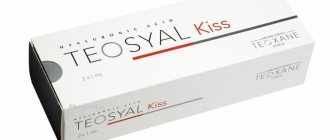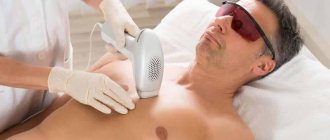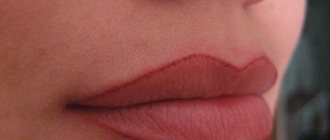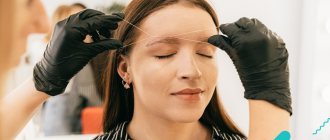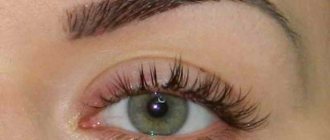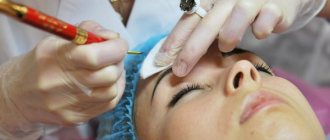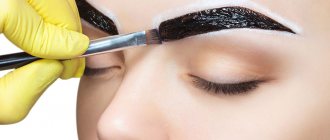Services Doctors Results Reviews
Expert tested
Avdeyuk Elena Vladimirovna Dermatovenerologist, cosmetologist
Publication date: April 30, 2022
Review date: November 07, 2022
A person's face is in constant motion. We smile, frown, squint our eyes, raise our eyebrows, purse our lips in displeasure... And all this several hundred times a day.
The facial muscles located under the skin are under constant tension because of this: they stretch or, conversely, contract. As a result, more and more wrinkles appear on the skin, it stretches and sags.
Botox (Dotox) will help you relax spasmodic muscles and “wean” your face from harmful facial expressions.
Today, the name Botox has become almost a household word; it is used to refer to the procedure for smoothing wrinkles on the forehead.
Zhmurina Natalya Borisovna
Director, Chief Physician of “A Clinic” Dermatovenerologist, cosmetologist
But in fact, Botox is a world-famous American drug created on the basis of botulinum toxin type A.
History of Botox
Bacteria that temporarily paralyze muscles (Clostridium botulinum) were discovered at the end of the 19th century, but more than 60 years passed before scientists came up with a rational use for them. In the late 1960s, Edward Shantz and Alan Scott began testing botulinum on monkeys. Later, this substance began to treat excessive sweating, strabismus, blepharospasm and achalasia of the esophagus.
In cosmetology, botulinum toxin began to be actively used at the turn of the 20th and 21st centuries. This happened after the discovery of ophthalmologist Jean Carruther: she noticed that under the influence of botulinum toxin, the orbicularis oculi muscle “crow’s feet” in the corners of the eyes noticeably contract.
Indications
Complications often occur for a reason. Typically due to:
- Failure to comply with the recommendations of the treating specialist during the rehabilitation period.
- Incorrect dosage.
- Medical illiteracy
- Incorrect drug injection site.
- Overdose of a harmful substance.
- Using a low quality drug.
Indications for removing the active component:
- asymmetry of zones. Cause: excessive raising of the brow arches;
- diffusion of drugs;
- increased level of lacrimation, severe dryness of the mucous membrane of the eyeballs. Additionally: rapid deterioration of visual acuity;
- ptosis. Result: significant drooping of the upper eyelids;
- increased level of salivation. Additionally: dysfunction of the speech apparatus.
Help: correctly diagnose the cause that resulted from the formation of consequences. Action: quickly correct the situation, determine methods for removing the component from the patient’s body.
How does botulinum toxin work?
In youth, the skin is elastic, and small wrinkles that appear as a result of the movement of facial muscles are easily smoothed out. However, with age, elasticity decreases and wrinkles become deeper. In addition, facial muscles acquire the ability to fixate in one position. For example, if a person is used to frowning, the facial muscles are fixed in a constant spasmodic position. A person has to make a huge effort of will to give his face a friendly expression.
Botulinum toxin drugs block neuromuscular transmission. When Botox is injected into a muscle, its ability to contract is reduced. And when the muscle does not contract, the skin over it does not fold. Wrinkles are gradually smoothed out. In this case, the muscle does not atrophy, because the blood supply to it does not stop, which means that nutrients continue to flow to the muscle fiber.
Contrary to rumors, facial expressions after using drugs based on botulinum neurotoxin do not disappear, but simply become calmer and more controlled. The face will not turn into a mask and will not lose its expressiveness. You will still frown, smile, be surprised. Only longitudinal grooves will disappear on the forehead, deep folds on the bridge of the nose, “crow’s feet” around the eyes, and “marionette lines” between the nose and the corners of the lips. The skin will glow with health and youth!
Can I withdraw it quickly?
Reason: lack of result. Kinds:
- regular massages and treatments. Principle: gentle massage, high intensity. Result: impact on epidermal cells, restoration of the muscle layer. Recommendations: lymphatic drainage;
- physiotherapy. The principle is based on stimulation of damaged muscles with minimal current pulses. Help: Darsonval and myostimulation are prescribed. Effect: rapid increase in muscle performance, improved blood circulation in the subcutaneous tissue. Consequences: rapid withdrawal of the active component;
- physical exercise.
- Additionally: aerobics class. Action: regular performance of gymnastic exercises – facelifting. Result: impact on the drug injection sites. Tip: regularly turn your head to the sides.
Where is Botox injected?
Botox is most effective in the upper third of the face. The forehead and area around the eyes are its zones of influence. This is where the results of the procedure will be most noticeable.
Wrinkles and folds in the lower part of the face in most cases are not the result of excessive muscle work, but depend on the characteristics of the bone structure of the face, the elasticity and density of the skin and subcutaneous fat, as well as age-related loss of facial volume.
It is recommended to correct the lower part with Botox if there is an obvious muscle spasm: for example, a person constantly clenches his jaw or purses his lips. In this case, Botox will be able to soften the emerging nasolabial folds, relax the jaw, and even slightly enlarge the lips if the pursing of them is eliminated.
There is also the mesobotox technique. This is a subdermal injection of microdoses of the drug, which allows you to smooth out fine purse-string wrinkles around the mouth.
What are Botox injections used for in cosmetology and plastic surgery?
- Botox injections (botulinum therapy) are used to smooth out and correct hyperkinetic folds - facial wrinkles in the forehead, between the eyebrows, outer corners of the eyes (crow's feet wrinkles), longitudinal wrinkles of the bridge of the nose, vertical fine wrinkles of the upper and lower lips, and folds of the chin , reducing the severity of horizontal wrinkles in the neck and décolleté area.
- With Botox injections you can lift the eyebrows, the corners of the mouth, slightly tighten the oval of the face, and raise the tip of the nose.
- Botulinum therapy can also be used to improve the results of plastic surgery both before and after surgery.
How is the procedure performed?
Botox should be administered only in a trusted clinic, and not in the first one you come across. Despite the fact that the drug has been on the market for a long time and has proven itself, it is still a toxin that is injected into the facial muscles. Therefore, injections should be given by a doctor who understands the mechanism of how the facial muscles work “from” to “to” and knows exactly at what point and how many units to inject in order to achieve the desired effect.
Botox injections are placed shallowly into the muscles and leave virtually no marks. The procedure takes about 15 minutes.
Immediately after the injections, small papules are noticeable at the injection sites, but they resolve within 10-20 minutes. Therefore, immediately after the injections you can go about your business: work, walk, relax. The only rule: for 3-4 hours do not take a horizontal position and do not lower your face down. This is required for better absorption of Botox by the muscles and to prevent swelling.
In the first days after the procedure, it is recommended to frown and grimace more often so that the drug is evenly distributed in the muscles.
What factors affect how long Botox lasts?
- Physical activity. In athletes, results disappear faster. This is due to increased metabolism and developed muscles that are difficult to block. Even increasing the dose does not always help. Extensive physical activity immediately after injections is especially harmful. When moving, botulinum toxin may shift inside the tissues and will not penetrate the desired points. In the worst case scenario, displacement of the drug will lead to facial asymmetry.
- Place of injection. Constantly working muscles, for example, those that cause the eye to blink, are quickly released from Botox, so the drug often has to be pinned in the area around the eyes.
- Features of metabolism. The more intense it is, the faster the drug is eliminated from the body.
- Thermal procedures. As the temperature rises, blood and lymph flow increases, which accelerates the elimination of the drug. Therefore, after the administration of Botox, it is not recommended to abuse the sauna, steam bath and other procedures associated with general heating of the body.
- Physiotherapy aimed at working muscles. Various interventions involving muscle stimulation enhance toxin removal, especially if they are carried out immediately after injections. It is undesirable to use magnetic therapy, intense massage, ultrasound therapy, or infrared laser in the Botox injection area. All this reduces the activity of botulinum toxin and accelerates its elimination.
- Medicines used. The effect of Botox is influenced by taking a number of medications. Some can strengthen it, while others can lubricate it. In some cases, the combination of drugs and Botox is unpredictable. Against the background of botulinum toxin, it is undesirable to take tetracycline antibiotics, lincosamides, polymyxins, erythromycin, Succinylcholine, Quinidine, Darifenacin, Orphenadrine, Disopyramide and some other drugs. Therefore, when prescribing medications, you need to inform your doctor about the injections performed, especially if they were done recently.
- Drinking alcohol. It is not advisable to drink alcohol within 7 days after botulinum toxin injection, as it interacts with the drug, reducing its effect. The product may be distributed unevenly, which will lead to facial asymmetry.
These factors explain the difference in the speed and strength of the effect and the different duration of action of Botox. To speed up and prolong the result, you need to coordinate your lifestyle with the recommendations of a cosmetologist.
How long does the effect last?
The effect of Botox begins to appear 3-4 days after injections. A person is getting younger right before our eyes. At the same time, a good doctor will make sure that you can smile, frown and raise your eyebrows in surprise, as before, but wrinkles and creases will not remain on the skin.
The effect of Botox will last for 4-6 months, sometimes longer. This depends on the rate at which the drug is eliminated by the body. Botox is a biodegradable drug; it does not accumulate in the body, but is removed from it through the lymphatic system. By the way, with regular administration of Botox, the effect of the drug lasts longer and the frequency of procedures can be reduced to once a year.
How long does Botox last and how to prolong its effect?
Anti-aging injections have long become an integral part of our lives. They help prolong youth, correct facial features, and improve skin condition. But they have, by and large, one drawback - sooner or later the miraculous effect will definitely end.
How long does Botox last? This question is usually asked when the procedure has been performed perfectly and you want the result to last as long as possible. But it also happens that the specialist’s hand, as they say, trembles and it is necessary to return the face to its previous appearance as quickly as possible. Will it be possible to prolong the effect of the toxin in the first case and what can be done to make the muscles mobile again in the second? What medications and procedures will help? Why are 1-2 sessions a year enough for some people, while others have to go to a cosmetologist every 2-3 months? TecRussia.ru tells in detail:
↑ How long do injections last?
- Manufacturers of drugs based on botulinum toxin type A promise that the pronounced effect of injections lasts for about 3-6 months.
- Practicing cosmetologists agree with this: they consider the duration of action to be from 2 to 6 months as the norm, and 3-4 months as the average.
However, this period will be strictly individual for each individual patient, since it depends on many additional factors. The most important of them is the frequency of procedures. It is believed that for the best results, Botox should be injected regularly (“the gold standard” is 3 times a year) into the same areas of the face: firstly, if the target facial muscles have not had time to fully recover after the previous session, then new injections will work much better. And secondly, the permanently paralyzed fibers weaken over time, decrease slightly in size and no longer pull the adjacent skin into wrinkles and folds even after the toxin ceases to act.
- Review of drugs based on botulinum toxin: which analogue is better?
- Complications and side effects of Botox: what consequences can there be and how to avoid them?
However, sometimes the exact opposite situation is possible: with each subsequent session, the patient’s sensitivity to botulinum toxin decreases slightly, and the ability of muscles to contract is restored in a shorter time, sometimes up to 2 times faster - i.e. a kind of vaccination effect occurs.
In this case, in order to achieve a good result without constantly increasing the dosage, you should maintain a sufficiently long period of time between injections. For the most popular areas of injection of the drug - the forehead, between the eyebrows and the area in the corners of the eyes - it would be optimal to carry out one procedure every 9-12 months. With this scheme of botulinum therapy, the initial muscle paralysis caused by the toxin persists for about 3-5 months, then for another 2-3 months these areas remain relatively motionless due to the fading of the habit of wrinkling the forehead or squinting. The muscles will need some more time to restore their original tone and contractility - and only after that does it make sense to conduct another session.
| How to determine that the effect of injections will end soon: The main and only sign that the paralytic effect of Botox is weakening is the restoration of mobility of the facial muscles in the treated area. It is not difficult to notice if you observe the condition of your face in the mirror every day. Then, after a fairly short time, the wrinkles that were caused by the contraction of these muscles “return”. Ideally, you shouldn’t wait for this moment: it’s time for the next injection session. |
↑ What other factors influence the duration of the result?
In addition to the frequency of procedures, a number of other circumstances are also significant, including:
- How many units were administered: the more, the longer the drug will work (however, the difference here is not linear, so it is not advisable to overdo it for the sake of a longer-lasting effect).
- In which specific area are the injections given? On average, Botox lasts longer in the forehead and between the eyebrows than around the eyes. The exception is people with a massive, “heavy” eyebrow area. Usually the muscles in this area are very strong and therefore restore their activity after paralysis much faster than any others.
- The metabolic rate in the body: the higher it is, the faster the original tone in the treated area will return.
- Gender: men's facial muscles are slightly stronger than women's, so the results from the same amount of the drug will last less on average.
- Age: in older patients the effect always lasts longer, since they have weaker regeneration abilities, incl. and tissues recover more slowly from paralysis.
- Peculiarities of local immunity: in some people, the body is able to recognize botulinum toxin molecules as foreign and destroy them before the connection between muscle fibers and nerve endings is disrupted. The result of the procedure in this case will be minimal and will not last long.
↑ How to extend the resulting effect?
In addition to the above, it is also important how the patient behaves after the injections, how carefully he follows the cosmetologist’s recommendations, and how often he is exposed to treatments that prolong or reduce the effect of botulinum toxin:
| Group of factors | Prolongs the effect | Reduces |
| Massage | In the first hours after the procedure, you can knead the treated areas using a special technique that the cosmetologist will demonstrate. This promotes uniform distribution of the injected drug in the tissues, which allows for a more natural and long-lasting correction result. | A general facial massage reduces the effectiveness of injections, since the muscles eventually become toned faster and restore their ability to contract. |
| Cosmetology procedures | Biorevitalization, bioreinforcement, volumetric correction with fillers - in themselves, do not affect the duration of action of botulinum toxin, but complement and enhance its rejuvenating effect, due to which it is possible to do with a smaller dosage and increase the intervals between procedures. | Any thermal effects, microcurrents, ultrasound, electromyostimulation, galvanic and magnetic therapy contribute to the rapid restoration of the work of facial muscles. Chemical, laser and mechanical peelings locally accelerate metabolism and blood circulation, stimulate the activity of the immune system, which also reduces the duration of action of Botox and any of its analogues. |
| Medicines | In total, more than three hundred drugs have now been experimentally identified that enhance the paralyzing effect of botulinum toxin - these include, in particular, tetracyclines and some other groups of antibiotics, magnesium sulfate, any muscle relaxants, etc. But trying to prolong the effect of the procedure with their help is extremely dangerous, since the health consequences can be unpredictable. | B vitamins, a number of psychotropic substances and antidepressants contribute to a more rapid restoration of neuromuscular transmission in tissues. In practice, they cannot be used for this purpose, of course, due to possible negative consequences for the nervous system and the entire body as a whole. |
| Alcohol | – | Causes blood flow to the skin, including to the face (remember how after the first glass of champagne your cheeks turn pleasantly pink?). This helps to increase the speed of metabolic processes, which, among other things, accelerates the restoration of muscle tone. |
| Physical exercise | – | Intense exercise accelerates blood circulation (especially when performing bending exercises) and metabolism. This promotes rapid removal of the drug from tissues and restoration of motor activity of paralyzed muscles. |
↑ Can a cosmetologist influence the duration of the result?
- The main tasks of the doctor performing the injections are to follow the correct technique, as well as inject Botox with an understanding of the anatomy of the facial muscles and where exactly the toxin should go. Simply injecting a given dosage somewhere into the area of emerging wrinkles will be a waste of the drug (and the patient’s money). And the ideal option is if the injections are performed by a plastic surgeon, one who constantly works with the muscular structures of the face when performing a lift of the upper third or blepharoplasty and knows everything about their structure and functions. Of course, experience is no less important: good cosmetologists also develop the necessary qualifications over time, and a surgeon who has never touched a syringe is unlikely to be able to immediately provide the desired result. But other things being equal, it makes sense to give preference to the surgeon.
- Also, the preparation of the toxin is of great importance: it must be diluted immediately before injection. After just a few hours, such a solution begins to rapidly lose its quality. What can we say about cases when a syringe with the prepared drug waits for the patient in the refrigerator for several days!
↑ Briefly about the most important:
How long Botox will last directly depends on the individual characteristics and behavior of the patient. Normally, the paralyzing effect on muscle fibers lasts for 3-5 months. This period can be slightly extended or shortened:
- If you are satisfied with the resulting effect, it is enough to follow the doctor’s recommendations regarding the rules of facial care and not violate the basic prohibitions (alcohol, thermal procedures and active sports are especially dangerous in the first days after injections).
- When complications, side effects occur after the procedure, or for other reasons the reflection in the mirror is not pleasing, you can speed up the resorption of botulinum toxin with the help of physical therapy and facial massage.
- The best and longest lasting result will be if you do injections without waiting for the previous ones to completely wear off - on average, every 4 months. Those for whom this approach does not work should, on the contrary, increase the pause between sessions to 9-12 months.
Pros of Botox
The procedure is quick and simple, there is no rehabilitation period. You can get Botox injections during your lunch break. The procedure takes even less time than a traditional manicure.
Gradual and increasing effect of smoothing wrinkles over two weeks. This is very important for people who do not want to advertise their visits to beauty clinics.
Another significant advantage of Botox is that even after the botulinum toxin is completely removed from the body, a person retains the habit of not wincing or raising his eyebrows. Having gotten used to the new reflection in the mirror, a person will no longer want to return to life before Botox and will strive to maintain a beautiful face at all costs.
But it is worth remembering that Botox is not able to cope with deep wrinkles that have already appeared. In this case, only filling them from the inside with fillers based on hyaluronic acid or other modern fillers, such as calcium hydroxyapatite, will help.
What drugs are used
First generation drugs include Botox and Dysport, although they are also effective today.
But over a period of more than 30 years, laboratories around the world have produced many similar drugs under different names, for example Rifinex, Lantox, Xeomin, the properties of which are superior to their predecessors, and the active ingredient in them is the same botulinum toxin type A.
For example, the latest generation drug, Relatox, due to modern production technology and stabilization of the toxin, in comparison with Botox, has shown less reactogenicity (the ability to produce antibodies in our body), a longer duration of effect with a greater degree of smoothing of facial wrinkles.
Treatment of local hyperhidrosis
Hyperhidrosis of the palms, armpits, feet or face is often associated with endocrine disorders, neurological disorders, and hormonal changes in women. In some cases, excessive sweating can occur for no apparent reason, based on a genetic predisposition.
The most popular way to treat excessive sweating is Botox injections. The drug injected into the problem area blocks the transmission of nerve impulses and the functioning of the sweat glands. In conditions of lack of response to external stimuli, the amount of sweat produced is significantly reduced.
Therapy is local in nature. It does not disrupt the sweating process of the entire body, but acts in specific problem areas. Injections are made with thin needles, do not cause complications and have a narrow range of contraindications. The effect of the procedure becomes noticeable on days 2-4 and lasts stably from six months to one and a half years.
Glushkova Yulia Gennadievna
- doctor of the highest qualification category,
- specialist in laser equipment for cosmetology and antiage therapy (LUMENIS, Solta Medikal, Zeltiq), photorejuvenation, hair removal, elimination of local fat deposits.
This operation can also be performed by Sergey Vladimirovich Sviridov, Sergey Alexandrovich Zolotov.
Inquiries and appointments from 9.00 to 21.00 by phone
What happens if you stop injecting Botox?
If you adhere to a competent approach to manipulation, observe the correct dosages and time intervals between courses, then stopping botulinum therapy will return the muscle to its natural state at that time.
Of course, if you have had the procedure done for many years, the muscle and skin will not be as “young” as before. Botox does not prevent age-related changes, but only temporarily masks them.
Use of medications
Prescribed for the effective treatment of botulism: convulsive provocateurs, increases the number of muscle contractions. Help: the treating specialist prescribes antibacterial components of the tetracycline category. Reason: Effectively breaks down harmful toxins. There are contraindications: problems with liver and kidney failure. The doctor prescribes strong antidepressants, hormonal pills, and antiviral drugs. Alcohol consumption
When administering injections of the active substance, cosmetologists inform about the prohibition of alcohol consumption. Help: patients mistakenly imply the process of accelerating metabolism. Advice: ban on drinking alcoholic beverages during the rehabilitation period. Methods to reduce the effects of Botox
The patient can reduce the level of exposure to the active ingredient. Professional cosmetologists prescribe effective procedures. Types of effective techniques:
- magnetic stimulation;
- electrical stimulation. Principle of action: rapid reduction of side effects with incorrect dosage;
- ultrasound therapy. Operating principle: effective impact of ultrasound on the motor functions of tissue molecules. Benefits: rapid removal of harmful toxins, increased metabolism, regeneration of damaged cells;
- galvanization. Advantages: direct effect on damaged areas of the skin. Result: rapid muscle relaxation, removal of harmful toxins from the patient’s body. Disadvantage: 10-15 sessions required;
- Darsonval. The principle of operation is based on the direct influence of small pulses with alternating current. Advantages: the equipment increases the patency of nerve endings and increases the number of muscle contractions. Result: becomes noticeable after 10 sessions;
- classic massage procedure.
Reference: the methods are applied based on the results of a preliminary comprehensive diagnosis of the negative effects of the active component of Botox. Professional cosmetologists prohibit self-medication. Reason: rapid deterioration of health.
Price
The price of the service is determined individually. There are many reasons.
| Factor | Peculiarity |
| Complication level | The abundance of side effects requires an integrated approach |
| Volume of active substance introduced into the patient’s body | The method of detoxification of the patient is determined |
| Methodology | Depends on the level and nature of complications |
| Medical Center | The clinic determines the cost independently |
| Rehabilitation period | The need is determined by the chosen technique |
| Region | Place of residence dictates the market price of services |
Help: Consultation with a specialist is recommended. Tip: registration is made through the administrator of the medical center. Advantages of a private clinic
Advantages: • individual approach; • reverent attitude; • professional doctors; • recording for any time; • low price; • guarantee of results; • professional equipment; • goodwill, focus on results. Additionally: no side effects, quick withdrawal of Botox.

